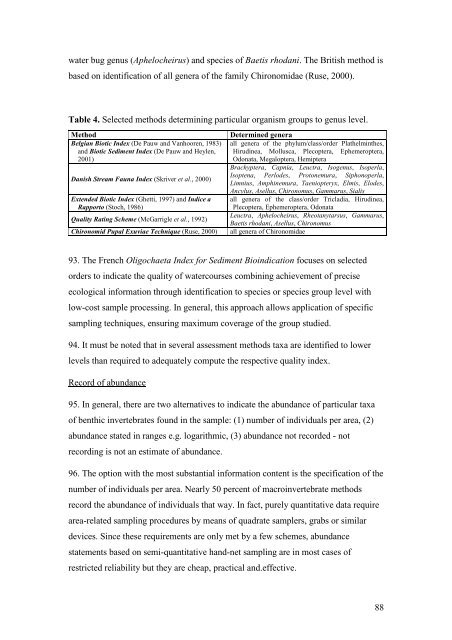Report on Harmonisation of freshwater biological methods
Report on Harmonisation of freshwater biological methods
Report on Harmonisation of freshwater biological methods
Create successful ePaper yourself
Turn your PDF publications into a flip-book with our unique Google optimized e-Paper software.
water bug genus (Aphelocheirus) and species <strong>of</strong> Baetis rhodani. The British method isbased <strong>on</strong> identificati<strong>on</strong> <strong>of</strong> all genera <strong>of</strong> the family Chir<strong>on</strong>omidae (Ruse, 2000).Table 4. Selected <strong>methods</strong> determining particular organism groups to genus level.MethodBelgian Biotic Index (De Pauw and Vanhooren, 1983)and Biotic Sediment Index (De Pauw and Heylen,2001)Danish Stream Fauna Index (Skriver et al., 2000)Extended Biotic Index (Ghetti, 1997) and Indice aRapporto (Stoch, 1986)Quality Rating Scheme (McGarrigle et al., 1992)Chir<strong>on</strong>omid Pupal Exuviae Technique (Ruse, 2000)Determined generaall genera <strong>of</strong> the phylum/class/order Plathelminthes,Hirudinea, Mollusca, Plecoptera, Ephemeroptera,Od<strong>on</strong>ata, Megaloptera, HemipteraBrachyptera, Capnia, Leuctra, Isogenus, Isoperla,Isoptena, Perlodes, Prot<strong>on</strong>emura, Siph<strong>on</strong>operla,Limnius, Amphinemura, Taeniopteryx, Elmis, Elodes,Ancylus, Asellus, Chir<strong>on</strong>omus, Gammarus, Sialisall genera <strong>of</strong> the class/order Tricladia, Hirudinea,Plecoptera, Ephemeroptera, Od<strong>on</strong>ataLeuctra, Aphelocheirus, Rheotanytarsus, Gammarus,Baetis rhodani, Asellus, Chir<strong>on</strong>omusall genera <strong>of</strong> Chir<strong>on</strong>omidae93. The French Oligochaeta Index for Sediment Bioindicati<strong>on</strong> focuses <strong>on</strong> selectedorders to indicate the quality <strong>of</strong> watercourses combining achievement <strong>of</strong> preciseecological informati<strong>on</strong> through identificati<strong>on</strong> to species or species group level withlow-cost sample processing. In general, this approach allows applicati<strong>on</strong> <strong>of</strong> specificsampling techniques, ensuring maximum coverage <strong>of</strong> the group studied.94. It must be noted that in several assessment <strong>methods</strong> taxa are identified to lowerlevels than required to adequately compute the respective quality index.Record <strong>of</strong> abundance95. In general, there are two alternatives to indicate the abundance <strong>of</strong> particular taxa<strong>of</strong> benthic invertebrates found in the sample: (1) number <strong>of</strong> individuals per area, (2)abundance stated in ranges e.g. logarithmic, (3) abundance not recorded - notrecording is not an estimate <strong>of</strong> abundance.96. The opti<strong>on</strong> with the most substantial informati<strong>on</strong> c<strong>on</strong>tent is the specificati<strong>on</strong> <strong>of</strong> thenumber <strong>of</strong> individuals per area. Nearly 50 percent <strong>of</strong> macroinvertebrate <strong>methods</strong>record the abundance <strong>of</strong> individuals that way. In fact, purely quantitative data requirearea-related sampling procedures by means <strong>of</strong> quadrate samplers, grabs or similardevices. Since these requirements are <strong>on</strong>ly met by a few schemes, abundancestatements based <strong>on</strong> semi-quantitative hand-net sampling are in most cases <strong>of</strong>restricted reliability but they are cheap, practical and.effective.88














![Accommodation booking form [PDF]](https://img.yumpu.com/39471785/1/184x260/accommodation-booking-form-pdf.jpg?quality=85)

